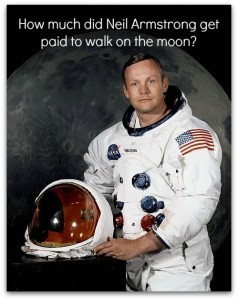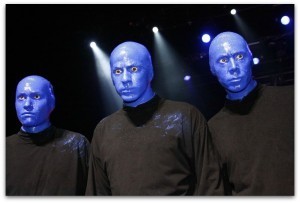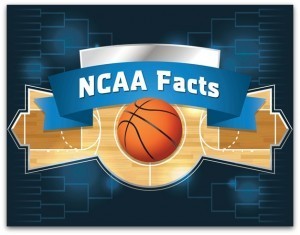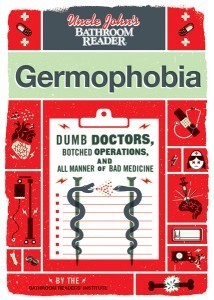Bathroom Readers' Institute's Blog, page 141
April 7, 2014
AUJA – A$tronaut Edition
Uncle John knows pretty much everything—and for when he doesn’t know, he heads into the dark recesses of his massive research library, or puts one of his many associates on the case. So go ahead: in the comments below, ask Uncle John anything. (And if we answer your question sometime, we’ll send you a free book!) This week’s question comes from reader Jeremy C.
How much did Neil Armstrong get paid to walk on the moon?
 When NASA astronauts Neil Armstrong, Buzz Aldrin, and Michael Collins landed on the moon in 1969, it was the biggest news story of the year – if not the biggest ever – and the public wanted to know as much as possible about Apollo 11, the moon, and the men who went there. A fun part of that were the nitty-gritty financials: How much did it really cost to go to the moon, and where did the money go?
When NASA astronauts Neil Armstrong, Buzz Aldrin, and Michael Collins landed on the moon in 1969, it was the biggest news story of the year – if not the biggest ever – and the public wanted to know as much as possible about Apollo 11, the moon, and the men who went there. A fun part of that were the nitty-gritty financials: How much did it really cost to go to the moon, and where did the money go?
In 1969, NASA reported that it had been allocated about $23.915 billion in tax money in the ten years since it had been founded with the express purpose of putting a man on the moon. A lot of that money went to establishing a new government department, and with it the bureaucracy, infrastructure, salaries for office workers, as well as funding for ground control, launch sites, rockets, research, spaceworthy equipment, and extensive training for all involved.
Of the three Apollo 11 astronauts, Armstrong, the first man to set foot on the moon, earned the highest salary…but he didn’t get anything extra for going to the moon. Armstrong earned an annual salary of $27,401 in 1969. In today’s dollars, that’s $171,777—not bad at all, and at the very least, six times the average household income at the time. The other crew member to walk on the moon, Buzz Aldrin, earned $18,622 a year, and lunar pilot Michael Collins (who had to stay in the ship) took home $17,147.
Armstrong was on the moon for a total of about two hours and 40 minutes. To break it down to an hourly rate, Armstrong made $32.92 for his moonwalk. The “lunar surface outfit,” or the spacesuit that he wore while doing so, cost $300,000—or the equivalent of 12 years of his salary.
All three astronauts, did, however, earn a little bit more. Since they were all technically away from their base for the day (really far away), each could claim an $8 a day “per diem.”
The post AUJA – A$tronaut Edition appeared first on Uncle Johns Bathroom Reader.
April 4, 2014
It Came From ‘Germophobia’: A Plastic Surgery Nightmare
We’ve got a brand new book out this week: Uncle John’s Germophobia . It’s all about hospital horrors, bad doctors, botched surgeries, nightmare nurses, weird diseases, and all the things that can and will go wrong when it comes to your health. Here’s a taste of the kind of thing you’ll find inside.
 In 2011, a Utah woman named Jennifer Swalberg went in for two fairly routine plastic surgery procedures at the clinic of Dr. Joseph Berg: liposuction and an abdominalplasty (also known as a “tummy tuck”). Most of the details of what allegedly happened next were reported in a lawsuit filing, so, to say the least, things didn’t go well.
In 2011, a Utah woman named Jennifer Swalberg went in for two fairly routine plastic surgery procedures at the clinic of Dr. Joseph Berg: liposuction and an abdominalplasty (also known as a “tummy tuck”). Most of the details of what allegedly happened next were reported in a lawsuit filing, so, to say the least, things didn’t go well.
Swalberg says Berg wrapped her healing dressings so tightly that it indented the skin and irritated the incisions on her stomach. Swalberg returned to Berg’s clinic, who treated the wounds by soaking some gauze in antiseptic, then shoving it into the wounds…with his fingers. Then he pulled it out, and re-stitched the wounds. Those didn’t heal properly either, and Swalberg developed swelling, and hardened chunks of scar tissue all over her abdomen. Swalberg returned to Berg for more treatment, but he passed out in the hallway outside her exam room. (Really.) On the next appointment, Berg administered local anesthetic to Swalberg’s tender abdomen, disappeared for an hour, then returned to treat the scar tissue after the anesthetic had worn off. Swalberg says he stabbed at her wounds with a pickle fork – an actual pickle fork – in order to loosen the scar tissue. Those wounds soon became infected, and leaked blood and pus. Swalberg didn’t have any more follow-ups at the clinic, because she claims they stopped answering the phone when she would call.
This all happened around the same time that a state occupational licensing board began investigating Berg when his staff reported seeing him consume handfuls of painkillers and fall asleep standing up. Plenty of prescription drugs were also found at Berg’s home by police responding to a 911 call in November 2011…where they also found Berg’s girlfriend tied up and locked in a closet.
Berg served six months in jail for the attack; Swalberg’s lawsuit is still pending.
Want more horrors? Get
Germophobia
directly from our store, Amazon, Barnes & Noble, or your favorite retailer.
The post It Came From ‘Germophobia’: A Plastic Surgery Nightmare appeared first on Uncle Johns Bathroom Reader.
Fake-or-Fact Friday: Good News Edition
Two of these news items really happened. One of them only happened…in our minds. Can you tell which is the fake? The answer is below.
A.
There are eight schools in the prestigious Ivy League—Brown, Columbia, Cornell, Dartmouth, Harvard, Princeton, Yale, and the University of Pennsylvania. All are extremely hard to get into, unless you are one particular 17-year-old high-school-senior from Long Island who got into all of them. The student is a first-generation son of Ghanian immigrants. His guidance counselor was especially wowed. “It’s a big deal when we have students apply to one or two Ivies,” she told reporters. “To get into one or two is huge. This is extraordinary.” “The yesses kept coming!” said the student, who scored 2250 out of 2400 on the SAT. He got the idea to apply at all eight in the 10th grade as a fun challenge. He knows he wants to be a doctor, but he isn’t sure which school to attend, although he’s leaning toward Yale.
B.
Even good-natured pranks generally leave one of the parties involved feeling like a victim on some level. Not this prank. A Los Angeles waitress went about her normal shift, waiting tables, when suddenly she started getting very good tips. Very good tips. One tip was $1,000. Another was a trip to Hawaii. Then came a job offer, and then finally, the keys to a new car. It was all part of a website’s campaign to raise money for a social change charity.
C.
A team of biologists discovered a new species of forest mouse on Luzon Island in the Philippines. “Most mouse species actively avoid humans,” said project leader Dr. Lawrence Heaney from Chicago’s Field Mouse Museum. “These mice left what I can only describe as ‘offerings’ on team members’ sleeping bags.” Among the items found: earthworms, seeds… and a half-carat princess-cut diamond ring.
Want more fakes? Check out Uncle John’s Fake Facts. (Really!)
The post Fake-or-Fact Friday: Good News Edition appeared first on Uncle Johns Bathroom Reader.
April 3, 2014
The Life of a Blue Man
Feeling blue? Join the Blue Man Group!
 Since its inception in 1987, the Blue Man Group performance art/music collective has entertained millions with its shows in New York, Las Vegas, cruise ships, and touring throughout the U.S. and Europe. Dozens have (mostly anonymously) put on head-to-toe blue makeup to perform with the group, but how did they get there? As Tobias on Arrested Development discovered, it’s pretty hard.
Since its inception in 1987, the Blue Man Group performance art/music collective has entertained millions with its shows in New York, Las Vegas, cruise ships, and touring throughout the U.S. and Europe. Dozens have (mostly anonymously) put on head-to-toe blue makeup to perform with the group, but how did they get there? As Tobias on Arrested Development discovered, it’s pretty hard.
A reporter for the Portland Mercury interviewed Blue Man Russell Rinker—a former lumberjack and Shakespearean trained actor—to find out more about the audition process. Rinker says acting experience helps, and so do drumming skills. (There is a lot of percussion in a Blue Man show. Saturday Night Live and Portlandia star Fred Armisen is a former rock drummer, and he did a sting in the BMG.) They also seem to favor a very certain physical type: between 5’10” and 6’1” with an athletic build. (Only one woman has ever been a Blue Man, a one-year member of the Boston cast.)
The average Blue Man takes about 45 minutes to put on his makeup and get suited up before a performance. They also have to follow certain rules while on stage. A Blue Man can never talk and can’t swing his arms. They also have “no ego,” meaning nobody is a standout or star, and must always behave in a curious manner. During the training process, junior members spend time at dog parks studying the nonverbal behavior of (blue?) man’s best friend.
But it’s not all serious, dramatic work. The Las Vegas crew also have their own bowling team and play in a league against cast members from other Vegas shows such as Mama Mia, Avenue Q, and Cirque du Soleil.
If you’re interested, the Blue Men’s wranglers hold annual auditions. The next one is scheduled for May 5th in Los Angeles.
The post The Life of a Blue Man appeared first on Uncle Johns Bathroom Reader.
Where Eagles Dare
Breaking into One World Trade Center is a bad idea. Sneaking all the way up to the roof is an even worse idea.
 Nevertheless, several daredevils recently engaged in both of these activities (and managed to evade the skyscraper’s round-the-clock security team in the process).
Nevertheless, several daredevils recently engaged in both of these activities (and managed to evade the skyscraper’s round-the-clock security team in the process).
Back in September, four New York City residents, led by construction worker James Brady, slipped through a hole in a fence surrounding the new WTC at 3 a.m. and made it inside, past the round-the-clock security team. Then they climbed to the top of the 104-story building, which isn’t scheduled to be opened to the public until later this year, and while one of them kept watch, the others parachuted off the edge.
They would’ve gotten away with it, too, had a surveillance camera not caught video of the whole thing. The NYPD arrested all four on March 24th. They’ve been charged with felony burglary, along with a few misdemeanors. If they’re fully convicted, each faces up to seven years in prison.
One of the thrill-seekers brought along a camera and filmed his entire 1,300-foot descent and uploaded to YouTube. Note: this video contains language some may find objectionable.
More recently, a New Jersey teenager named Justin Casquejo also reached the top. He snuck through a hole in the fence too and, as he later told authorities, “I found a way up through the scaffolding, climbed onto the sixth floor, and took the elevator up to the 88th floor. I then took the staircase up to the 104th floor.” A snoozing security guard didn’t notice Casquejo as he headed for the roof. The teen was later arrested. Casquejo is quite brave (or crazy, depending on your point of view). His Twitter account is filled with photos of him hanging off the edge of cranes and standing on various Manhattan rooftops.
Let’s just hope that all the attention that these daredevils are receiving won’t encourage others to follow their lead. Well, too late. Two CNN reporters tried their luck on March 25th and were arrested at one of the skyscraper’s gates.
The post Where Eagles Dare appeared first on Uncle Johns Bathroom Reader.
April 2, 2014
March Madness! Final Four Fever!
Some quick facts about the NCAA men’s basketball tournament.
 In 1939, Ohio State University basketball coach Harold Olsen came up with the idea of deciding the national champion each season with a 64-team tournament. (However, the term “March Madness” wasn’t coined until 1984, by the marketing team promoting the Final Four host city of Seattle.)
In 1939, Ohio State University basketball coach Harold Olsen came up with the idea of deciding the national champion each season with a 64-team tournament. (However, the term “March Madness” wasn’t coined until 1984, by the marketing team promoting the Final Four host city of Seattle.)Currently, the tournament fields 68 teams—with eight teams squaring off in pre-tournament games for four final spots. Then the 64 teams are split into four “regions” of 16 teams each, where they are numerically seeded based on their regular season records and national rankings. The #1 seed begins by playing the #16 seed, the #2 team plays #15, etc.
Anything can happen in a tournament, and it usually does. At least one of the four #1-seeded teams make it to the Final Four, but not always. In 2006, none of the remaining four were top-seeded—they were #3 UCLA, #3 Florida, #2 LSU, and #11 George Mason.
Only once have all four #1-seeded teams advanced to the Final Four. In 2008, North Carolina, Kansas, Memphis, and UCLA all made it. (Kansas meat Memphis in the final game.)
Never has a #16 team knocked out a #1 seed in the first round. Only rarely has a #15 team beat the #2 team. In 2013, Florida Gulf Coast made it all the way to the “sweet 16” round of the tournament, beating #2 Georgetown and #7 San Diego State. They’re the most successful low-seeded team in tournament history, all the more impressive considering that the FGC basketball program was only in its second year of tournament eligibility.
The most successful team ever in the NCAA basketball tournament: UCLA. The school has won 11 national titles, 10 of them in the 1960s and ‘70s under coach John Wooden. Between 1962 and 1975, the Bruins made the Final Four 12 times. In 10 of those 12 seasons, they won it all.
Biggest-ever Final Four rout: In the 1990 championship game, UNLV beat Duke 103 to 73. UNLV set still-standing records for most points scored and largest margin of victory in a title game.
The post March Madness! Final Four Fever! appeared first on Uncle Johns Bathroom Reader.
March 28, 2014
Can You Tell Me How to Get to the Bathroom on ‘Sesame Street’?
Finally, Uncle John can justify his daily viewings of Sesame Street.
 Since its 1969 inception, Sesame Street has been carefully written and planned by a team of educators with the goal of gently explaining many different aspects of life to preschool age children. That goes the same for the many international versions of the program, which feature characters or Muppets unique to or reflective of life in those areas. HIV rates are high in South Africa, for example, and that country’s Takalani Sesame features an HIV-positive Muppet named Kami.
Since its 1969 inception, Sesame Street has been carefully written and planned by a team of educators with the goal of gently explaining many different aspects of life to preschool age children. That goes the same for the many international versions of the program, which feature characters or Muppets unique to or reflective of life in those areas. HIV rates are high in South Africa, for example, and that country’s Takalani Sesame features an HIV-positive Muppet named Kami.
One of the biggest public health problems in the world today is that an estimated 2.5 billion people – nearly half of the world’s population – does not have access to clean water, good sanitation, or safe toilets. Until widespread improvements can be made, educating people, especially children, on how to use latrines properly, can be an effective way to prevent the spread of water- or fecal-born parasites and infections.
Sesame Workshop India, who produces a local version of Sesame Street has partnered with the Bill and Melinda Gates Foundation’s “Cleaner, Healthier, Happier” campaign to educate children on how to use latrines and toilets in a healthy and effective way. The method: a new Muppet on Sesame Street. Introducing Raya, a six-year-old, aqua-colored Muppet who encourages kids to always wash their hands after using a toilet, and to always wear shoes when visiting a public latrine.
And as if Uncle John didn’t already think this was all fantastic, Raya likes to remember and recite interesting facts and bits of trivia.
Raya will appear in a series of public health DVDs, print materials, and public service announcements that will be distributed throughout India, Bangladesh, and Nigeria.
The post Can You Tell Me How to Get to the Bathroom on ‘Sesame Street’? appeared first on Uncle Johns Bathroom Reader.
Fake-or-Fact Friday: Random News Edition
Two of these news items really happened. One of them only happened…in our minds. Can you tell which is the fake? The answer is below.
A.
Jerome Brittleman, 78, was attempting to retrieve a dollar bill that he’d spotted stuck in a segment of the walkway on an overpass in suburban Pittsburgh. The overpass was under construction, however, and Brittleman lost his footing and nearly fell off the 25-foot-high bridge. Brittleman, who told WTAE news that he weighs about 135 pounds, “only five pounds less than I did when I graduated high school,” thought he was lucky when his leather belt got caught in a piece of rebar that was jutting from one of the concrete supports. But he soon realized that he couldn’t lift himself back up to the bridge, and that traffic neither on nor under the overpass could see him. He was finally rescued when crews arrived to work Monday morning, 18 hours later. He was treated for exposure and dehydration, and is back home with his wife, Connie. Brittleman still wasn’t able to grab the dollar bill…but the construction crew retrieved it for him.
B.
A couple who collected more than $165,000 in public assistance from 2005 to 2012 were found to be living on a $1.2 million yacht in Florida are being sought on fraud charges. Colin Chisholm had been the CEO of a satellite TV and broadband services company and his wife, Andrea, sold and bred championship dogs. The couple claimed to be living in Minnesota, and collected the state assistance while they made deposits of more than $2.6 million into bank accounts that went unreported on their welfare applications.
C.
A restaurant in the Indian city of Ahmadabad offers a special setting to its diners by allowing the customers to enjoy their meal in the company of the dead. The restaurant was built atop a former cemetery, and rather than rip the graves out, the owner decided to incorporate them into the décor. “The graveyard brings good luck,” said the restaurateur of The New Lucky Restaurant. “Our business has been flourishing because of these graves. It gives people a unique experience.” The owner says he has no idea who the dozen graves belong to, but they are now sealed off by iron grills and are covered with cloth, decorated with fresh flowers and prayed over every day before the restaurant opens.
Want more fakes? Check out Uncle John’s Fake Facts. (Really!)
The post Fake-or-Fact Friday: Random News Edition appeared first on Uncle Johns Bathroom Reader.
March 27, 2014
Spring Break!
Hey, parents of college students: Your kids are using that tuition money you gave them to take a March trip to Florida. (Hey, college students: Your secret is safe with us!) Here’s a little bit about the history of Spring Break.
 The idea of Spring Break as one long beach party began in Spring 1938. Fort Lauderdale, Florida, hosted a “swim forum,” a meeting of more than 300 swimmers and coaches who all gathered in Florida to swim and socialize.
The idea of Spring Break as one long beach party began in Spring 1938. Fort Lauderdale, Florida, hosted a “swim forum,” a meeting of more than 300 swimmers and coaches who all gathered in Florida to swim and socialize.But the concept of college students hitting the beaches of south Florida for a week of misbehavior reached a national audience in 1986 – that’s the year MTV started round-the-clock coverage of the party scene with a week of programming airing partially live from Daytona Beach, Florida. The number of visitors to Florida each March began steadily rising.
College students spent about $2.1 billion on Spring Break trips, on average about $1,100 each. Because students don’t have a lot of money, many put it on credit cards, and that $1,100 contributes to about 5 percent of the average college student’s total post-graduate debt.
Daytona Beach once brought in more than a half a million vacationers at its 1990s peak. Despite the $120 million it brought to town, city planners hated the image that spring breakers were giving Daytona, so they rebranded the city as a family destination. Result: Daytona has been supplanted as the top Florida Spring Break destination by Panama City. More than 500,000 revelers flock there each year.
Other major hotspots include South Padre Island in Texas (about 150,000 visitors) and Cancun, Mexico (100,000).
According to the American Medical Association, Spring Break can be damaging to one’s health. In 2002, the AMA released a statement that said, “Spring Break is no longer an innocent respite from the rigors of college academics; it’s potentially life threatening.” Reason: The average student on vacation drinks a whopping 10 alcoholic drinks a day.
But not every college student is up to no good. Since 9/11 and Hurricane Katrina, thousands are using the week off from school to do volunteer work. It’s estimated that about 45,000 donate their time, with 10,000 of them working with Habitat for Humanity.
The post Spring Break! appeared first on Uncle Johns Bathroom Reader.
Impossible Questions: Weird Science Edition – The Answer
Think you’ve got a legitimate answer to this crazy question? Keep reading to see if you nailed it.
How are music superstars Lenny Kravitz and Bette Midler enemies of science?
Both Midler and Kravitz recorded very popular songs that make casual reference to basic scientific phenomena…and both got their facts completely wrong. Really!
In 1998, Kravitz released “Fly Away,” which went to #1 on the rock chart in the U.S. and around the world. At the beginning of the second verse, he sings, “Let’s go and see the stars / the Milky Way / or even Mars.” This is incorrect, as he seems to be describing things that are farther and farther away, topping each previous example. Except that those three things are progressively closer to each other. Distant stars are the farthest away, then our own Milky Way galaxy, and then Mars, our neighboring planet.
Midler’s 1988 ballad “Wind Beneath My Wings” was featured in the movie Beaches, won the Grammy for Song of the Year, and topped the charts. The sentiment of the song is simple: the singer thanks a friend for always supporting her, for helping her metaphorically fly—the “wind beneath her wings.” The problem is that this is not how flight works. For the song’s narrator to “fly higher than an eagle”—or at all—wind would have to be moving above the wings, not below it. But it’s okay, Bette Midler…telling someone you’re the “wind beneath their wings” sounds like a completely different kind of wind…
Want more impossible questions? Check out Uncle John’s Impossible Questions.
The post Impossible Questions: Weird Science Edition – The Answer appeared first on Uncle Johns Bathroom Reader.




